Exercises (2276)
Extension and flexion of the arms with rotation of the upper body in kneeling position alternating ► wood chop / downward woodchop
Power
Individual work


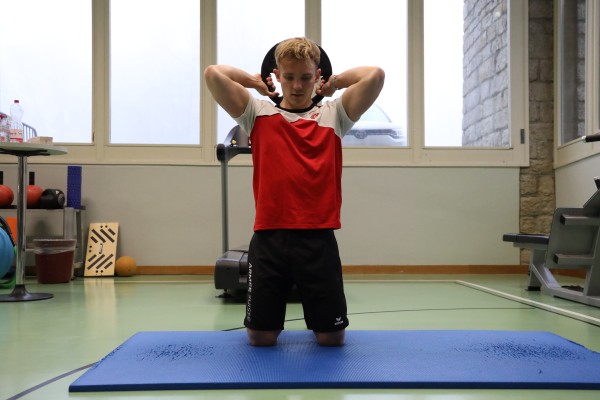
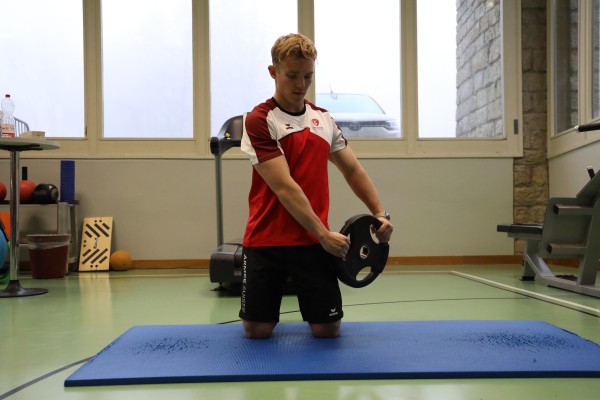
Kneel with your upper body upright. Hold the weight with both hands behind your head (arms bent accordingly, elbows pointing diagonally forwards at head height). From this position, straighten your arms and bring them down diagonally to one side of your body (at an angle of approximately 45 degrees, weight at hip height). Then bend your arms back to the starting position.
Attention:
Keep your upper body upright and tense your core.
Lighten:
Less weight.
Harden:
More weight.
1 weight disc/dumbbell/kettlebell
Extension and flexion of the arms with rotation of the upper body while standing
Power
Individual work
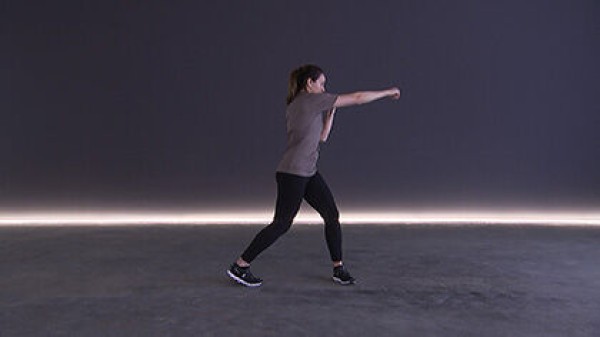
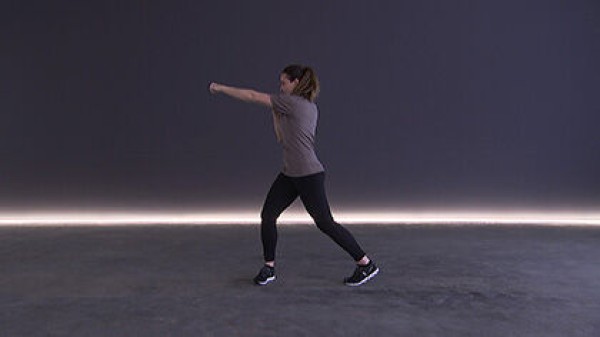
A distinction is made between the left-handed and right-handed stance. Right-handers take the left stance (left foot in front), while left-handers take the right stance (right foot in front). The left-hand stance: The left foot is placed one step forwards from a parallel stance approximately shoulder-width apart so that the right hand is behind. The right hand corresponds to the striking hand, the left hand to the leading hand. The distance between the two feet is approximately one shoulder width, with the feet on a diagonal to each other. The front foot stands on the whole sole, the heel of the back foot is raised. Both feet point forwards and the weight is evenly distributed over both legs. The front shoulder is turned slightly inwards. The entire body is slightly crouched, the knees are slightly bent and soft. The striking hand is placed in front of the chin and rests against the body. The lead hand is in front at eye level. The fists point outwards with the back. The arms are in front of the body and the elbows point downwards so that the arms cover the body. Alternately or in a free rhythm, the punching or leading hand is extended straight forwards (punching movement). In contrast to the straight line with the punching hand, there is little or no rotation of the upper body during the straight line with the lead hand.
Attention:
Always hold your arms high (chin or eye level).
Lighten:
Smaller movements/lower intensity of the punching movement (less rotation when moving with the punching hand).
Harden:
Hold additional weight on the arms or in the hands.
2 weight cuffs/weight balls/dumbbells ► Make the exercise more difficult (additional weight)
Extension and flexion of the arms with rotation of the upper body while standing
Power
Individual work
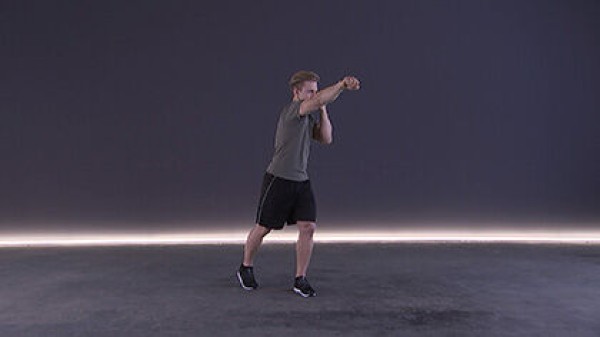
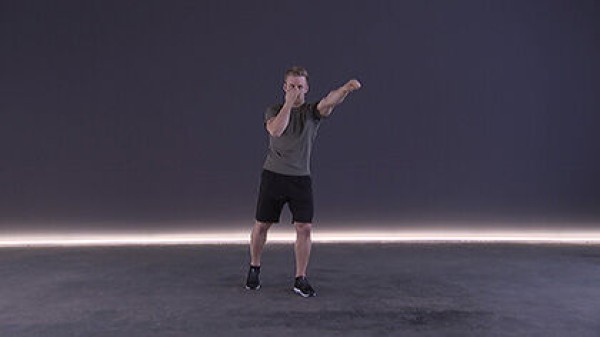
Stand upright with your feet shoulder-width apart (legs parallel), arms bent in front of your body (elbows at chest height), hands closed, alternately extend one arm diagonally forwards (open fist, palm facing downwards) and turn your upper body at the same time.
Attention:
Always hold your arms up (hands at eye level).
Lighten:
Smaller movement (less rotation).
Harden:
Hold additional weight on your arms or in your hands.
2 weight cuffs/weight balls/dumbbells ► Make the exercise more difficult (additional weight)
Alternating extension and flexion of the arms and legs while seated ► hollow hold row
Power
Individual work


Sitting, legs drawn up and slightly raised off the floor (knees by the chest), upper body upright, arms in front of the legs (pointing forwards in the direction of gaze), stretch the legs, simultaneously lean back with the upper body and bring the arms back towards the body/bend the arms so that the hands touch the chest (rowing movement). Then reverse the sequence of movements by pulling/angling your legs back to the starting position, stretching your arms again and straightening your upper body.
Attention:
Do not put your legs (and upper body) down.
Lighten:
Extend your legs less; only hold the centre position.
Harden:
Additional weight on/on the legs; hold additional weight on the arms/in the hands.
2-4 weight cuffs/2 weight balls/1 weight disc/(medicine) ball/sandbag/2 dumbbells ► Make the exercise more difficult (additional weight)
Alternating extension and flexion of the arms and legs while seated ► hollow hold row
Power
Individual work
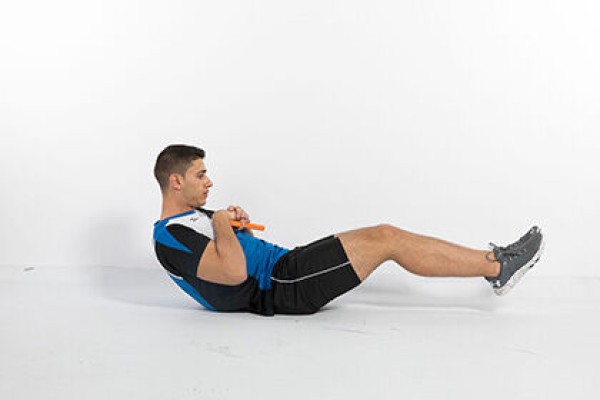
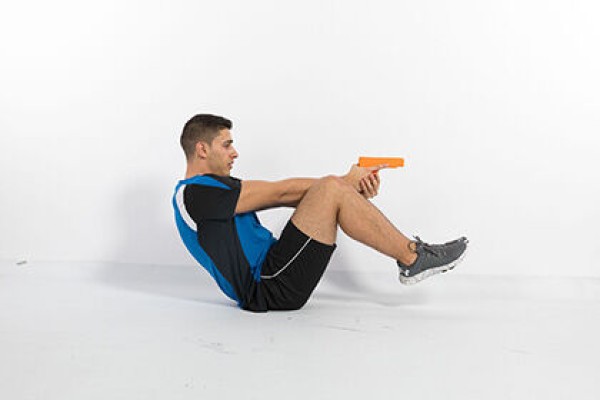
Sitting, legs drawn up and slightly raised off the floor (knees by the chest), upper body upright, hold the pistol in both hands with outstretched arms in front of the knees, stretch the legs, lean back with the upper body at the same time and bring the arms (pistol) back towards the body/bend the arms so that the hands touch the chest (rowing movement). Then reverse the sequence of movements by pulling/angling your legs back to the starting position, stretching your arms again and straightening your upper body.
Attentkin:
Do not lower your legs (and upper body).
Lighten:
Extend your legs less; only hold the centre position.
1 pistol (neutralised)
Alternating extension and flexion of the arms and legs while seated ► hollow hold row
Power
Individual work
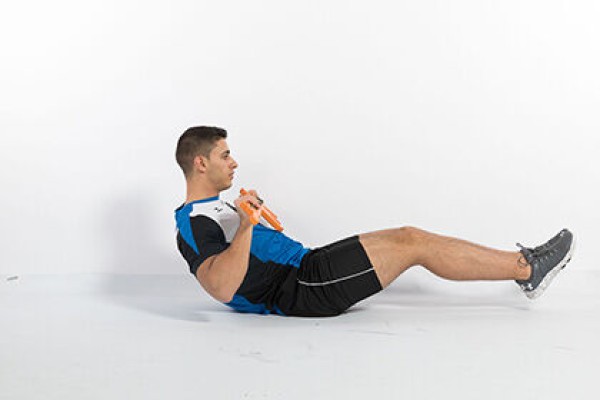

Sitting, legs drawn up and slightly raised off the floor (knees at chest), upper body erect, hold assault rifle with arms outstretched in front of knees (arms pointing forwards in line of vision, barrel/piston pointing to the side), straighten legs, simultaneously lean back with upper body and bring assault rifle/arms back towards body/arms bent so that assault rifle/hands touch chest (rowing motion). Then reverse the sequence of movements by pulling/angling the legs back to the starting position, stretching the arms again and straightening the upper body.
Attention:
Do not put your legs (and upper body) down.
Lighten:
Extend your legs less; only hold the centre position.
1 assault rifle (neutralised)
Extension and flexion of the arms and leg in single-leg stance (left) ► 1-leg romanian deadlift
Power
Individual work

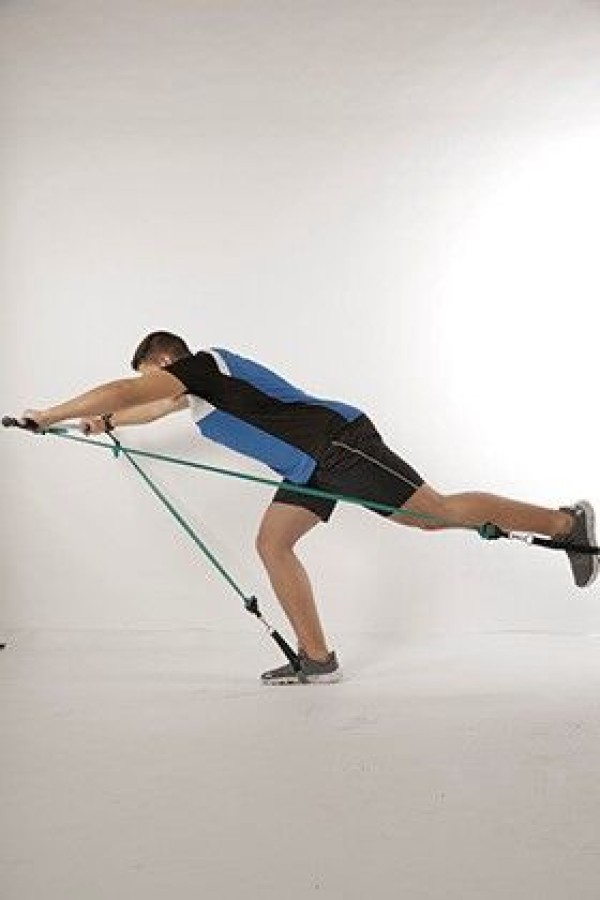
One-legged stand (right), upper body leaning forwards, both loops are attached to the slightly backwards and raised (left) foot (or only the loop on the side of the free leg and the other is attached to the supporting leg), the gymnastics pole is held with both hands in an overhand grip in front of the shoulders (palms pointing towards the floor) with tightened arms, At the same time, both arms and the free leg are stretched out horizontally against the resistance of the elastic bands and the upper body is leaned more forwards (standing balance), then the arms, free leg and upper body are returned to the starting position.
Attention:
No hollow back, tense the torso.
Lighten:
Select less strong elastic bands; roll up the elastic bands less.
Harden:
Select stronger elastic bands; roll up the elastic bands more.
Variation:
Attach the loops to both feet, alternating between stretching out the left and right leg at the same time with the arms (reach a standing position between each exercise).
1 gymnastic bar with elasticated straps
Extension and flexion of the arms and leg in single-leg stance (right) ► 1-leg romanian deadlift
Power
Individual work

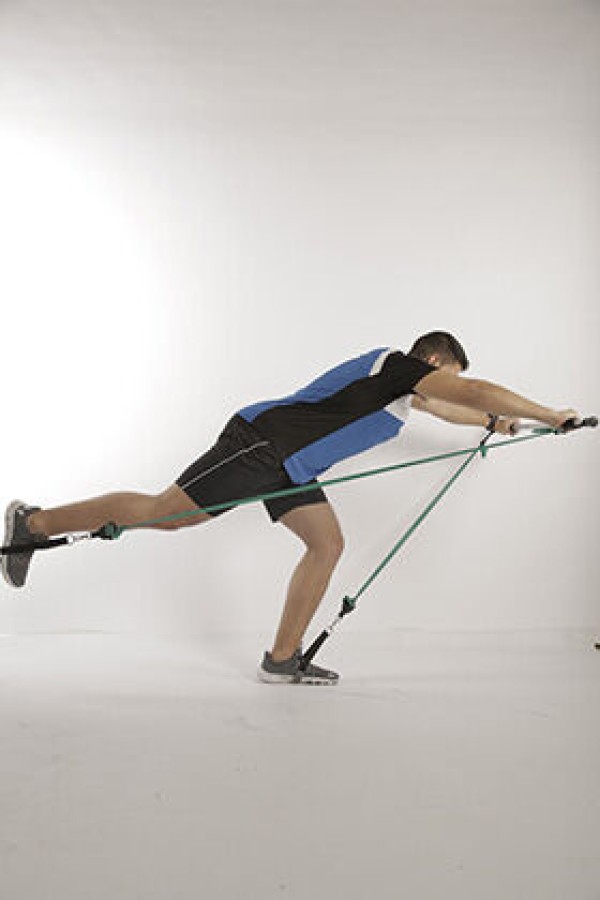
One-legged stand (left), upper body leaning forwards, both loops are attached to the slightly backwards and raised (right) foot (or only the loop on the side of the free leg and the other is attached to the supporting leg), the gymnastics pole is held in front of the shoulders with both hands in an overhand grip (palms facing the floor), At the same time, both arms and the free leg are stretched out horizontally against the resistance of the elastic bands and the upper body is leaned more forwards (standing balance), then the arms, free leg and upper body are returned to the starting position.
Attention:
No hollow back, tense the torso.
Lighten:
Select less strong elastic bands; roll up the elastic bands less.
Harden:
Select stronger elastic bands; roll up the elastic bands more.
Variation:
Attach the loops to both feet, alternating between stretching out the left and right leg at the same time with the arms (reach a standing position between each exercise).
1 gymnastic bar with elasticated straps
Extension and flexion of the arms and running in place
Power
Individual work
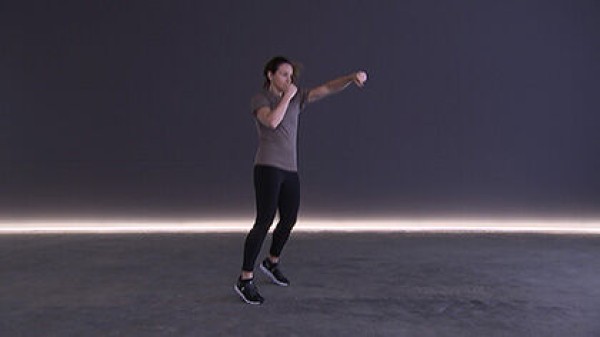
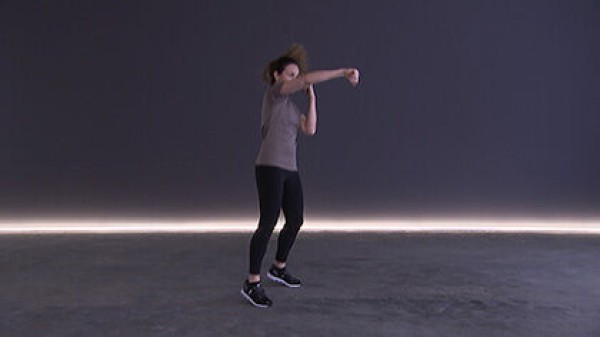
A distinction is made between the left-handed and right-handed stance. Right-handers take the left stance (left foot in front), while left-handers take the right stance (right foot in front). The left-hand stance: The left foot is placed one step forwards from a parallel stance approximately shoulder-width apart so that the right hand is behind. The right hand corresponds to the striking hand, the left hand to the leading hand. The distance between the two feet is approximately one shoulder width, with the feet on a diagonal to each other. Both feet point forwards and the weight is evenly distributed over both legs, with only the balls of the feet in contact with the floor (heels raised). The front shoulder is turned slightly inwards. The whole body is slightly crouched, the knees are slightly bent and soft. The striking hand is placed in front of the chin and rests against the body. The lead hand is in front at eye level. The fists point outwards with the back. The arms are in front of the body and the elbows point downwards so that the arms cover the body. The punching or leading hand is extended straight forwards alternately at a high frequency (fast, straight punching movements). The upper body always remains stable and faces forwards. During the punching movements, the legs are in motion all the time/standing trotting in place (punching hand and supporting leg on the same side).
Attention:
Always keep your arms up (chin or eye level), do not put your heels down.
Lighten:
Smaller movements/lower intensity of the punching movement.
Harden:
Hold additional weight on the arms or in the hands.
2 weight cuffs/weight balls/dumbbells ► Make the exercise more difficult (additional weight)
Alternating extension and flexion of the arms crosswise while standing ► hammer curl
Power
Individual work

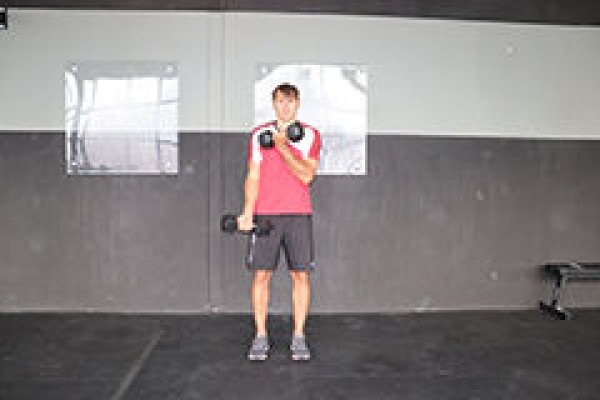

Stand upright, arms hanging with the dumbbells in your hands (neutral grip), the backs of your hands pointing to the respective side (away from your body), bend/bend your arms alternately to bring the dumbbell to the opposite chest/shoulder (back of your hands pointing forwards). The movement is performed using only the arm without support from the upper body. Lower the dumbbell back to the starting position by stretching the arm before starting the exercise with the other arm.
Attention:
Keep a straight back, do not lean backwards/forwards (you may need to do the exercise with your back against a wall). perform the exercise with your back against a wall to maintain the position), keep your elbows slightly in front of your body, work without momentum.
Lighten:
Less weight.
Harden:
More weight.
2 dumbbells
Extension and flexion of the leg and upward movement of the arms while standing (snatch) ► snatch
Power
Individual work
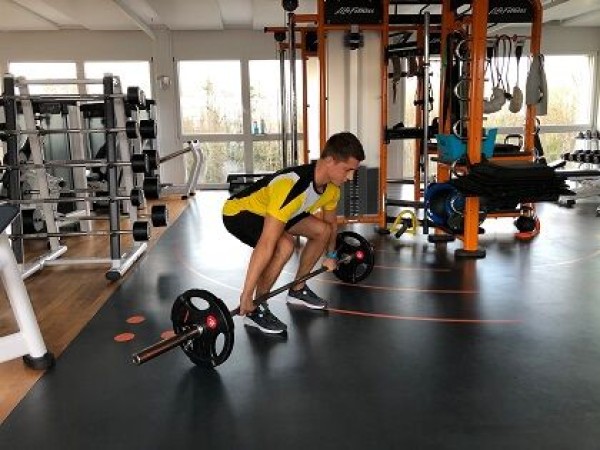
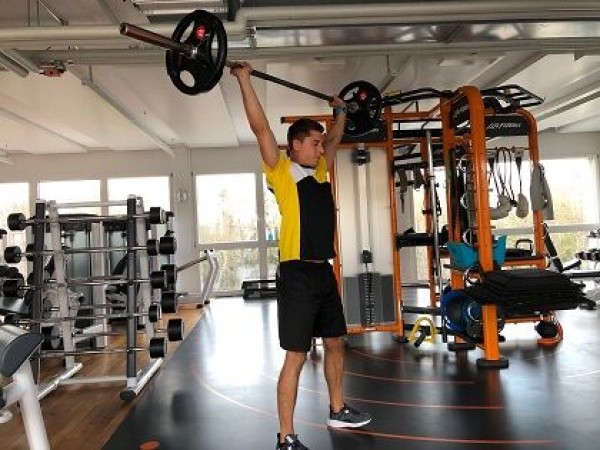
Squat down and grasp the barbell about shoulder-width apart (position the barbell over your midfoot), arms straight. By stretching your legs and moving your arms upwards, pull the barbell overhead (especially pushing it out of your legs) and stabilise the position with the weight held high.
Starting position:
- Squat, standing hip-width apart
- Upper body slightly bent forwards
- Grasp the barbell so wide that the bar is directly level with the hip crease when standing with arms extended
Finishing position:
- Stand upright
- Hold the bar overhead, arms outstretched in a slight V-position and held high
Attention:
This exercise is for advanced users only and requires a high level of knowledge, mobility and stability. Always make sure your back is straight (torso tension).
1 Langhantel
Extension and flexion of the legs in upright forearm support ► bent knee leg raise
Power
Individual work


Move your legs as slowly and controlled as possible to the squat position (pull your knees towards your upper body) and then return to the starting position at the same speed.
Starting position:
- Forearm support (back resting against the pad)
- Legs stretched
- No hollow back (tense abdomen)
Finishing position:
- Legs pulled up into squat position
- Buttocks slightly away from the pad
Attention:
Do not work with momentum and do not start from a hyperextended position. Be careful if you have problems in the lumbar spine.
Lighten:
Just hold the end position; lift your legs less.
Harden:
Exercise with straight legs; add weight on or between the legs.
1 strength tower/machine ► forearm support
2 weight cuffs/1 (medicine) ball ► make the exercise more difficult (additional weight)
Extension and flexion of the legs in lunge (left)
Power
Individual work
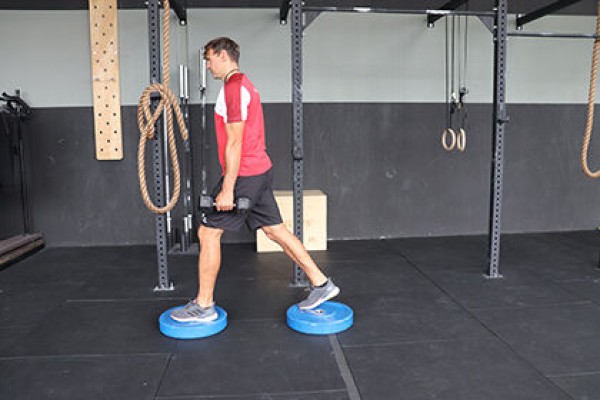

Two weight plates are placed on the floor at some distance so that each foot can be placed in the centre of the plate (left leg in front) in a (long) lunge. The heel of the rear leg is lifted from this V-position with the legs stretched out and the upper body upright (standing on tiptoe). Hold a weight (dumbbell or kettlebell) in both hands with hanging arms. Bend the front (and back) leg to approximately a right angle (buttocks at knee height of the front leg, knee of the back leg almost touching the floor), then straighten both legs to return to the starting position.
Attention:
Always keep the front knee behind the tip of the foot and centred over the foot.
Lighten:
Lower your upper body less (greater angle at the knees); stand on the floor (without weight plates); less or no weight.
Harden:
Additional weight.
Variant:
Weight(s) with arms outstretched at chest height in front of you (if necessary, rotate your upper body to the side and back in a lunge).
2 weight discs
2 dumbbells/kettlebells
1 weight waistcoat ► to make the exercise more difficult (additional weight)
Extension and flexion of the legs in lunge (left)
Power
Individual work
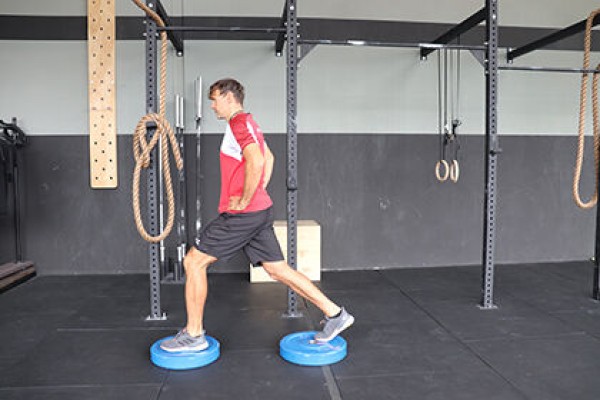

Two weight plates are placed on the floor at some distance so that each foot can be placed in the centre of the plate (left leg in front) in a (long) lunge. The heel of the rear leg is lifted from this V-position with the legs stretched out and the upper body upright (standing on tiptoe). The arms are supported on the hips or are at chest height in a holding position. Bend the front (and back) leg to approximately a right angle (buttocks at knee height of the front leg, knee of the back leg almost touching the floor), then straighten both legs to return to the starting position.
Attention:
Always keep the front knee behind the tip of the foot and centred over the foot.
Lighten:
Lower your upper body less (greater angle at the knees); stand on the floor (without weight plates).
Harden:
Additional weight (hold in your hands with hanging arms or in front of you).
Variant:
Hold your arms in front of you (possibly with weight), rotate your upper body to the side and back in a lunge.
2 weight discs
2 dumbbells/kettlebells/1 weight waistcoat ► Make the exercise more difficult (additional weight)
Extension and flexion of the legs in lunge (right)
Power
Individual work
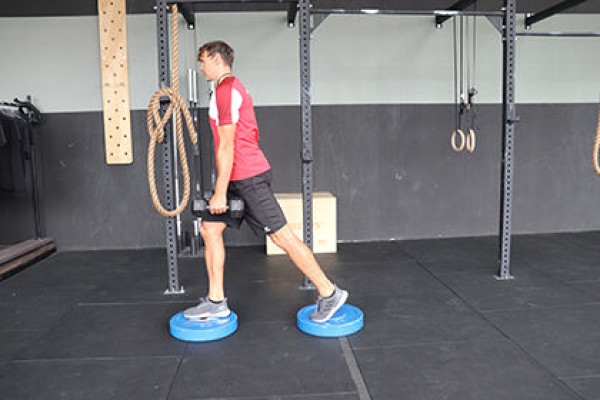
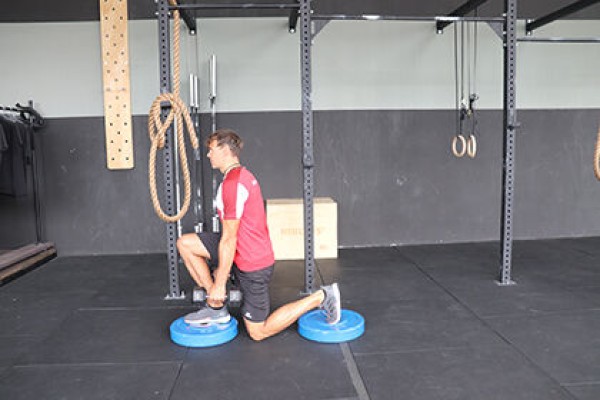
Two weight plates are placed on the floor at some distance so that each foot can be placed in the centre of the plate (right leg in front) in a (long) lunge. The heel of the rear leg is lifted from this V-position with the legs stretched out and the upper body upright (standing on tiptoe). Hold a weight (dumbbell or kettlebell) in both hands with hanging arms. Bend the front (and back) leg to approximately a right angle (buttocks at knee height of the front leg, knee of the back leg almost touching the floor), then straighten both legs to return to the starting position.
Attention:
Always keep the front knee behind the tip of the foot and centred over the foot.
Lighten:
Lower your upper body less (greater angle at the knees); stand on the floor (without weight plates); less or no weight.
Harden :
Additional weight.
Variant:
Weight(s) with arms outstretched at chest height in front of you (if necessary, rotate your upper body to the side and back in a lunge).
2 weight discs
2 dumbbells/kettlebells
1 weight waistcoat ► to make the exercise more difficult (additional weight)
Extension and flexion of the legs in lunge (right)
Power
Individual work
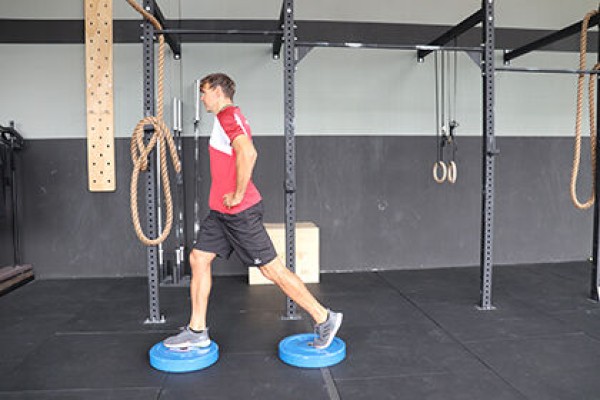

Two weight plates are placed on the floor at some distance so that each foot can be placed in the centre of the plate (right leg in front) in a (long) lunge. The heel of the rear leg is lifted from this V-position with the legs stretched out and the upper body upright (standing on tiptoe). The arms are supported on the hips or are at chest height in a holding position. Bend the front (and back) leg to approximately a right angle (buttocks at knee height of the front leg, knee of the back leg almost touching the floor), then straighten both legs to return to the starting position.
Attention:
Always keep the front knee behind the tip of the foot and centred over the foot.
Lighten:
Lower your upper body less (greater angle at the knees); stand on the floor (without weight plates).
Harden:
Additional weight (hold in your hands with hanging arms or in front of you).
Variant:
Hold your arms in front of you (possibly with weight), rotate your upper body to the side and back in a lunge.
2 weight discs
2 dumbbells/kettlebells/1 weight waistcoat ► Make the exercise more difficult (additional weight)
Extension and flexion of the legs in an elevated position ► leg extension
Power
Partner work
1 trainee & 1 helper ► Note change of position
(= double the time required; for lesson planner see Organisation Kraft: Info button Execution)

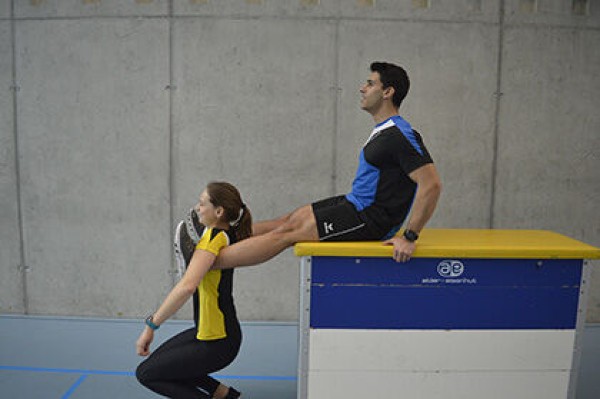
Exerciser: Sit upright on the edge of the vaulting box, straighten and bend your legs.
Partner: Hang on to the active participant's feet with your armpits and use part of your own body weight to counter the extension of the exerciser's legs.
Attention:
Always listen to/respond to your partner (adjust pressure/intensity). Do not push your knees all the way through.
Lighten:
More support from your partner (less weight/resistance).
Harden:
Less help from your partner (more weight/resistance).
1 Swedish box
Extension and flexion of the legs while seated (leg curl) ► leg curl
Power
Individual work
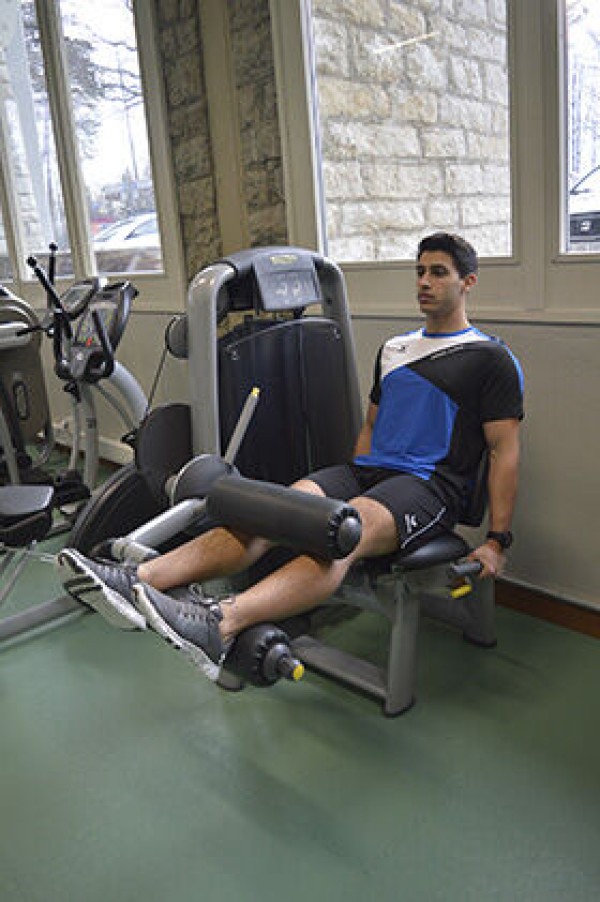
In a seated position, move the lower legs towards the buttocks and back to the starting position in a controlled movement without momentum.
Starting position:
- Sitting, legs pointing almost straight ahead
- The knees are level with the axis of rotation of the device
- The foot pad is level with the ankle
- Buttocks and back fully seated, torso tensed
Final position:
- Knees bent, heels slightly behind the knees
- Press against the pad using the handles, the back does not move.
Attention:
No hollow back, the movement takes place exclusively in the knee joint (lower leg).
Variant I:
Perform the exercise on one leg to counteract any muscular imbalance.
Variant II:
The exercise can also be performed using the 2:1 method: push down with two legs and alternately bring only one leg back up.
1 strength tower/machine ► leg curl
Extension and flexion of the legs while seated (leg extension) ► leg extension
Power
Individual work
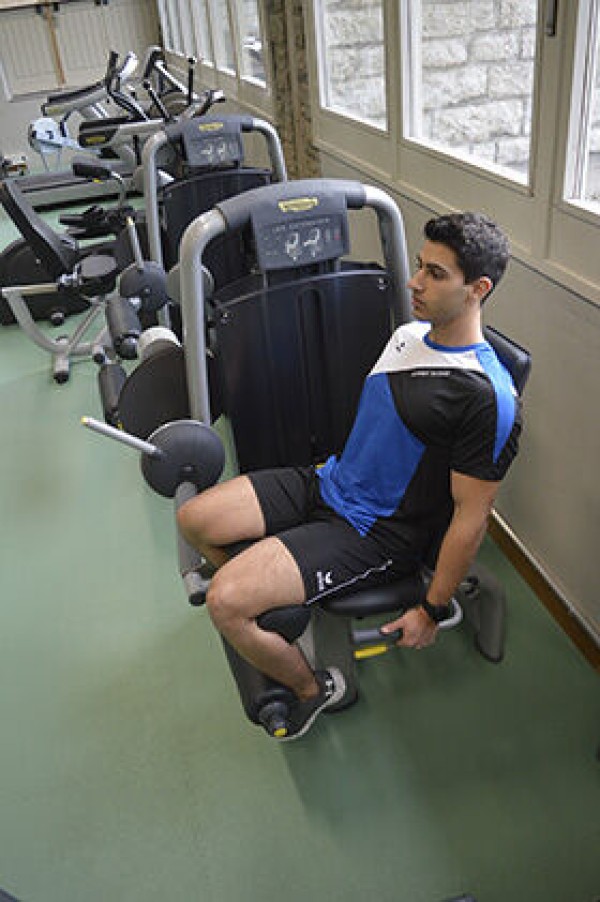
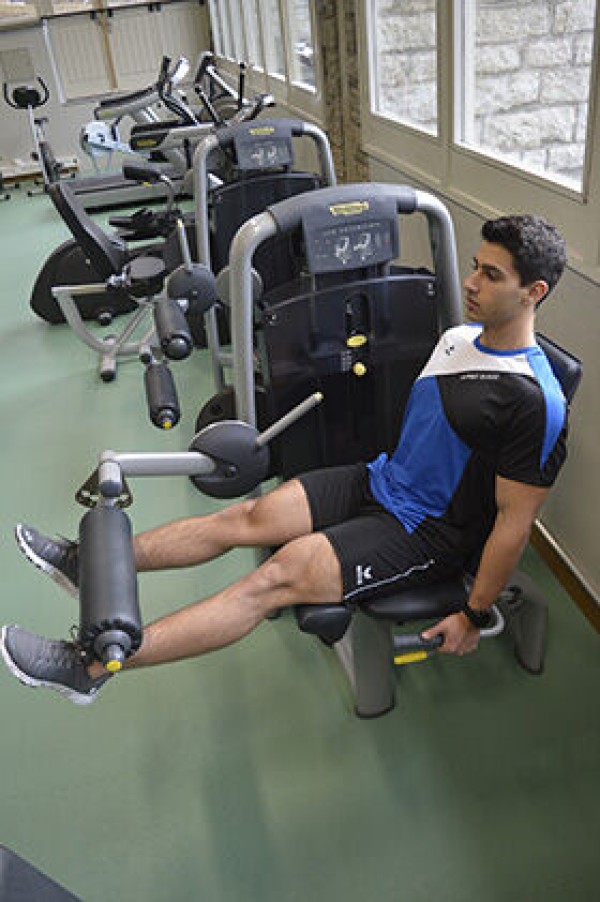
In a seated position, push your lower legs up in a controlled movement without momentum and return to the starting position.
Starting position:
- Sitting, knees at right angles, heels slightly behind the knees
- The knees are level with the axis of rotation of the device
- The foot pad is level with the ankle joint
- Buttocks and back fully seated, torso tensed
Final position:
- Press your lower legs up until they are parallel to the floor and your legs are almost stretched out and pointing forwards
- Keep your back and buttocks firmly in the seat
Attention:
Do not make a hollow back, the movement only takes place in the knee joint (lower leg), do not fully extend your knees.
Variant I:
Perform the exercise on one leg to counteract any muscular imbalance.
Variant II:
The exercise can also be performed using the 2:1 method: push down with two legs and alternately bring only one leg back up.
1 strength tower/machine ► leg stretcher
Extension and flexion of the legs while seated ► crunch kick
Power
Individual work


Sitting on a chair with your upper body leaning slightly backwards, lift your legs off the floor and bend them (pull your knees towards your body). To hold the position better, hold on to the chair with your hands (e.g. grasp the seat, grip the armrest or cross your arms behind the backrest). From this position, stretch your legs out so that they are pointing diagonally forwards (the further horizontally towards the floor, the more difficult) and bend back into the starting position.
1 (office) chair
Extension and flexion of the legs while seated ► crunch kick / knee in
Power
Individual work
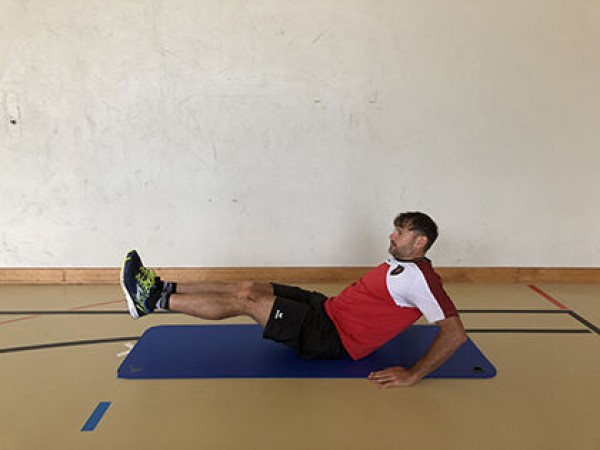

When seated, use your arms to support your upper body, which is leaning slightly backwards, bend your outstretched, raised legs (knees at buttock height) and stretch them forwards back to the starting position (bend and stretch your legs).
Attention:
Do not put your legs down completely.
Lighten:
Just hold the position with slightly bent legs (without stretching the legs), stretch the legs out less.
Harden:
Additional weight on, between or on the legs.
2 weight cuffs/1 weight disc/(medicine) ball/sandbag ► Make the exercise more difficult (additional weight)
Extension and flexion of the legs while seated ► leg press
Power
Individual work
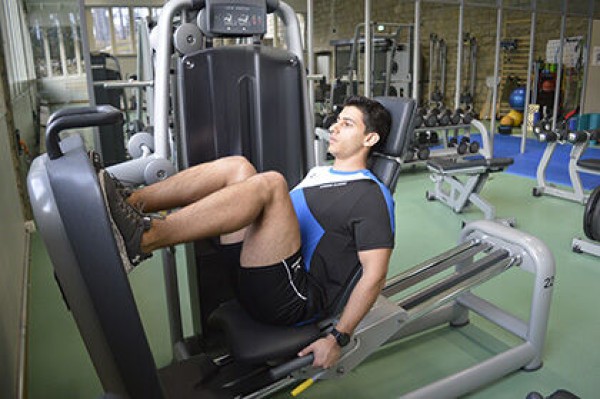

In a slow and controlled movement, press the weight away from the body and then bring it back again.
Starting position:
- Feet rest with the whole sole hip-width apart
- Knee angle is at least 90 degrees
- Back lies flat on the seat (no hollow back)
Finishing position:
- Do not fully extend the knees
- Lower back remains firmly in the seat
- Ankle, knee joint and hip are in line
Attention:
Push the knee outwards (do not allow it to tilt inwards), distribute pressure over the entire foot, do not fall into a hollow back.
Variant I:
The target muscles are changed by changing the position of the feet. The higher the feet are, the more the gluteal muscles are used. If the stance is widened and the feet point outwards, the inner thighs are trained more.
Variant II:
The exercise can also be performed with one leg.
1 weight tower/machine ► leg press
Extension and flexion of the legs while standing (deadlift) ► deadlift
Power
Individual work
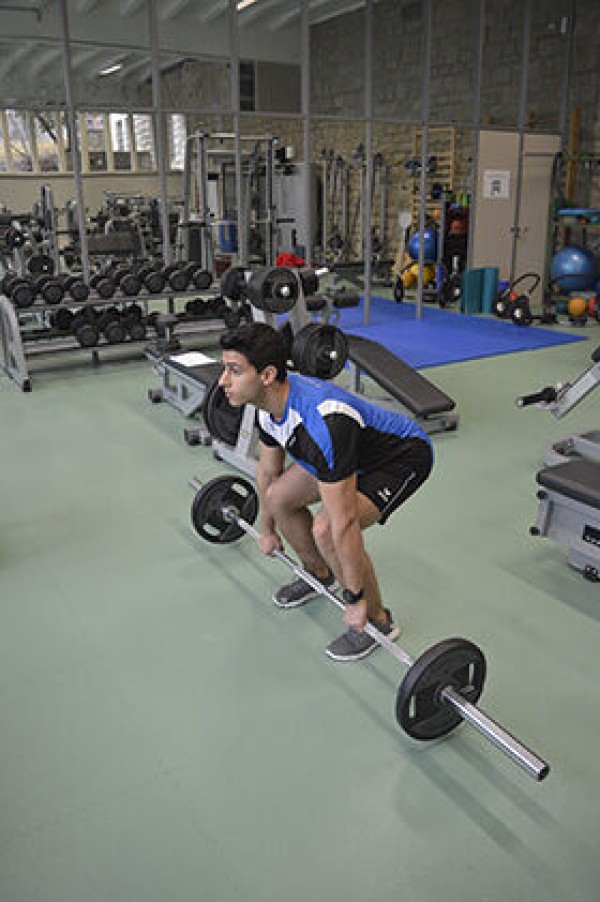

Grab the barbell lying on the floor with an overhand grip (or cross grip) from a squat position, keeping your arms straight and your back straight. By stretching your legs and straightening your upper body, pull the barbell up close to your legs to hip height (arms always straight). Then, when lowering the weight, first bring your hips back and down before bending your knees back to the starting position.
Starting position:
- Squat position, outstretched arms grasp the barbell at shin height, feet under the barbell
- Grasp the barbell shoulder-width apart with an overhand or cross grip
- Back is straight and tense, buttocks pushed back (hip hinge)
- Keep your head straight
Finishing position:
- Stand upright, arms and legs stretched
- Back straight (abdomen tensed)
- Shoulder blades pulled back in a fixed position
Attention:
In the starting position, the floor should be pushed away, creating more tension in the back and buttocks. Never lift the bar with a hunched back, otherwise there is a risk of strain injuries (always keep your back straight). If you are unsure, only train with the bar without (or with little) weight until you have learnt the movement sequence.
1 Langhantel
Extension and flexion of the legs in support ► knee tuck
Power
Individual work

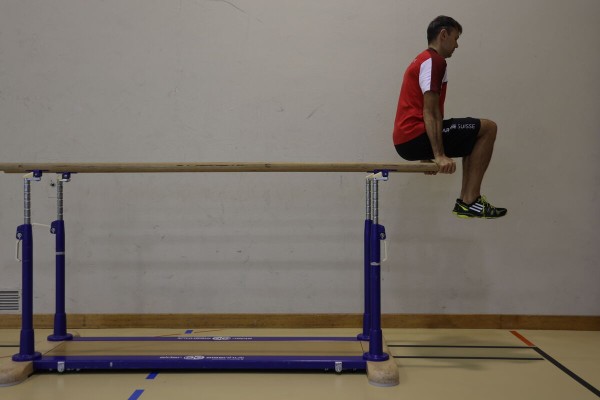
Support yourself on the bar (end), body stretched out, legs pointing (closed) towards the floor, bend both legs at the same time and raise your knees to the height of your belly button. Then stretch your legs back to the starting position (raise and lower your legs).
Attention:
Maintain a stable upper body/arm position during the exercise (elbows close to the body), slightly forward with the upper body, perform the movement in a controlled manner.
Lighten:
Lift your legs less.
Harden:
Add weight (on/between the legs).
Variation:
Bend one leg alternately.
1 parallel bars
2 weight cuffs/1 (medicine) ball/dumbbell ► Make the exercise more difficult (additional weight)
Extension and flexion of the legs in forearm support ► leg press
Power
Individual work
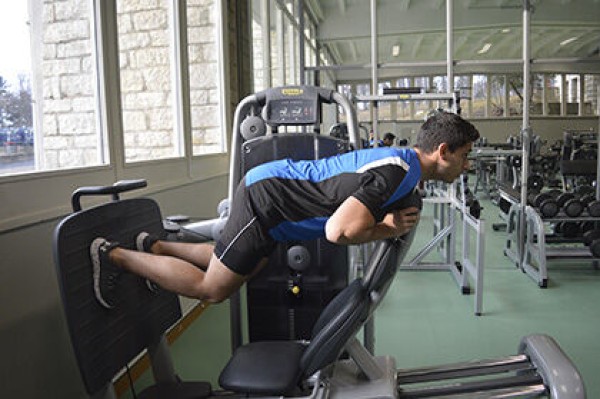

Forearm support on the flat bench, feet on the plate, in a slow and controlled movement, press the weight away from the body and return to the starting position.
Starting position:
- Forearm support on the flat bench (face down)
- Feet are hip-width apart and rest with the entire sole on the footplate
- The knee angle is at least 90 degrees
Finishing position:
- Knees not fully extended
- Back remains straight
- Ankle joint, knee joint and hip are in line
Attention:
Push your knees outwards (do not allow them to tilt inwards), distribute pressure over the whole foot, do not fall into a hollow back.
1 weight tower/machine ► leg press